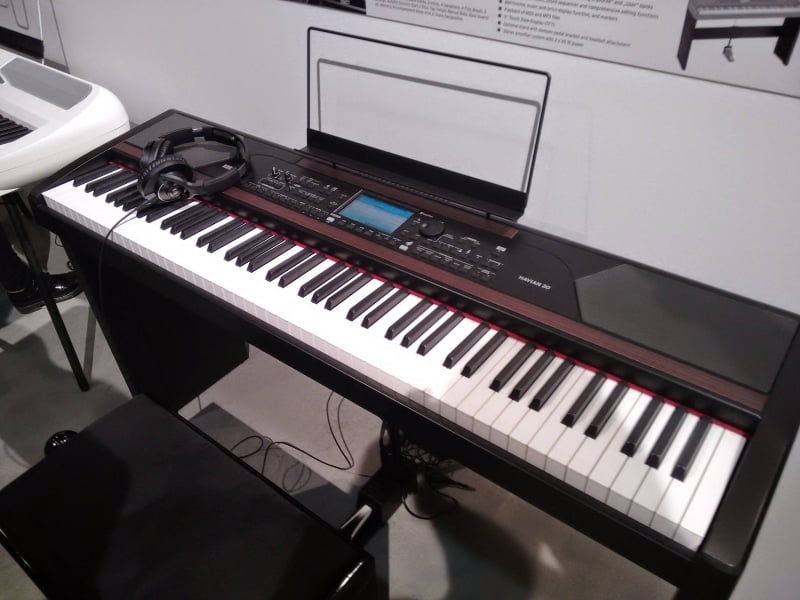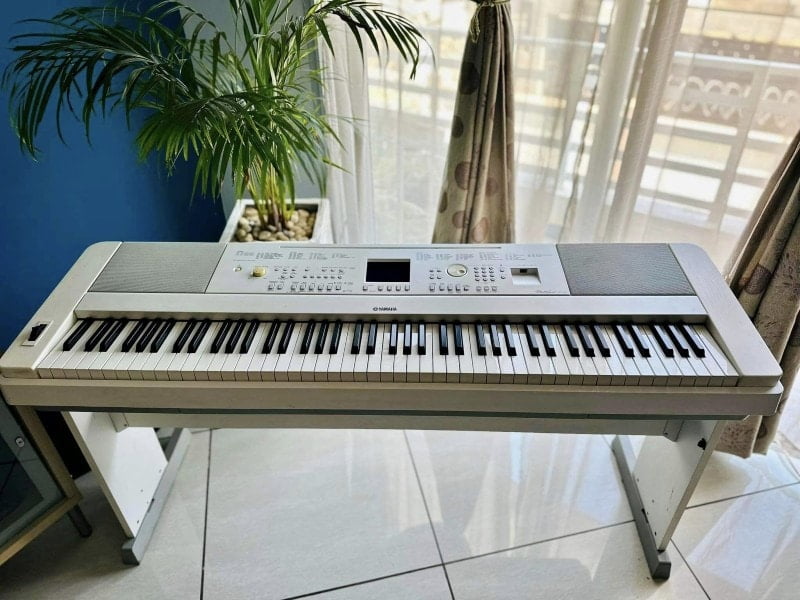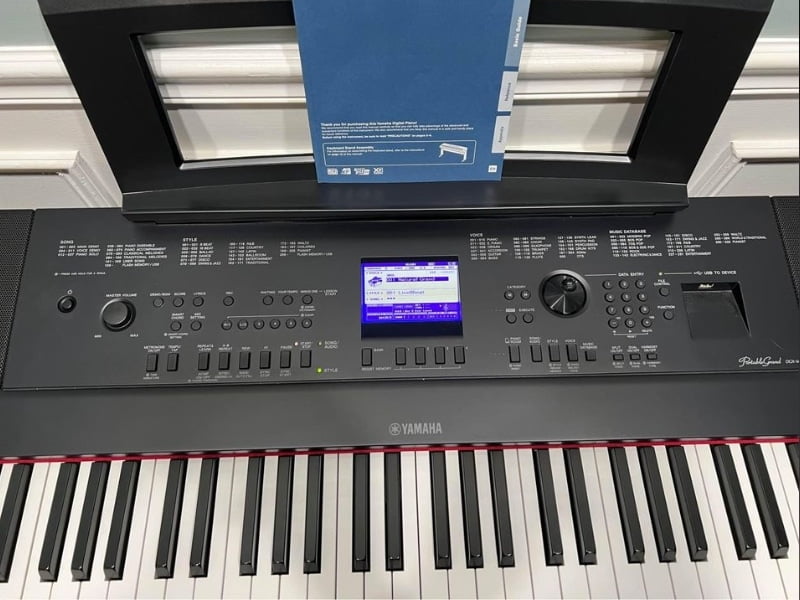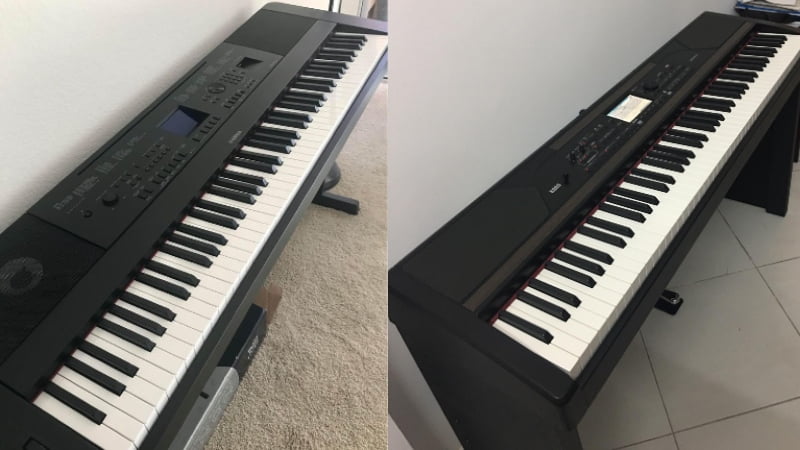Learn all the features, benefits, and drawbacks of both pianos as we compare these instruments in this Yamaha DGX-660 vs Korg Havian 30 review.
Korg and Yamaha are considered giants in the world of digital pianos. Both brands are known for producing some of the best digital pianos on the market, which is why I was really excited to make this Yamaha DGX-660 vs Korg Havian 30 review.
These are some of the best options from either brand and since they fall within the same relative price range, I knew I had to compare the two.
And after a bunch of tests and research, I found that the Yamaha DGX-660 offers the best value for the money. While the Korg can compete with the tones on the Yamaha, it falls short regarding feel and functionality.
So, if you’re choosing between these two pianos, I would highly recommend you go for the DGX-660. That said, some pianists may prefer the Korg Havian 30, which is why I made this comprehensive review that features both pianos.
And by the end of this comparison, you’ll know exactly which model to get to fulfill your needs.
Yamaha DGX-660 vs Korg Havian 30: Comparison Chart




Last update on 2025-04-14 / Affiliate links / Images from Amazon Product Advertising API
Yamaha DGX-660 vs Korg Havian 30: A Head-to-Head Comparison
When comparing digital pianos, I urge people always to consider the tone, feel, and the piano features. These are the defining characteristics of a digital piano and are arguably the most important ones to consider when buying a digital piano.
And based on these three comparison points, the Yamaha DGX-660 wins over the Korg Havian 30 with a score of 3-1. While the Korg put up a decent fight, it couldn’t compare with the functionality and features of the Yamaha, which is why I dubbed the latter the winner in this comparison.
Tone
The winner: Tie

You should never buy a digital piano without testing its tone. Nowadays, there are many digital pianos on the market, and some of them come with sub-par tones. Luckily, both the Yamaha DGX-660 and the Korg Havian 30 come with a varied set of fairly decent voices.
When I tested these pianos, I found that the Yamaha had a slight advantage in terms of tone quality. However, the Korg almost doubles the sound library of the Yamaha, which means you have more variety with this option.
Since both pianos have their own benefits regarding the tones they offer, I gave the point to both options.
+Tone Generation
A digital piano’s tone generator is responsible for tone quality. And between these two pianos, the Yamaha DGX-660 has the advantage. This is because the Yamaha uses the Pure CF Sound Engine, which is arguably the best tone generator you’ll find in this price range.
The Pure CF Sound Engine is a sample-based generator. This means that the piano is loaded with various recordings or samples of different instruments. Then, whenever you press a key, you trigger these samples.
The difference between the Pure CF Sound Engine and most of the other options from different brands is that the Pure CF Sound Engine derives its piano tones from Yamaha’s CF Grand Pianos.
It’s no secret that the CF grand pianos are some of the best available. So, you can expect very crisp, clear, and bright tones from the Yamaha. On top of that, the samples are very realistic, so the instrument sounds very close to a real acoustic piano.
On the flip side, the Korg uses a sample-based tone engine with Real Experience technology. This allows for a fairly realistic tone that can beat out many in its price range. However, I found that it fell short of Yamaha in this comparison.
So, if tone quality is your top priority, you’ll likely be better of with the Yamaha DGX-660.
+Sound Library
The reason I awarded a point to both pianos in this comparison was that the Korg offers a better sound library even if the Yamaha has higher-quality samples. When you choose the Korg, you get a sound library with over 900 different tones. This encompasses just about all the sounds you will need as a pianist and more. This is why the Havian 30 is a top choice for artists that play many different genres of music.
The Yamaha’s sound library is also great, but not as varied as the Korg. You have around 550 voices on the Yamaha DGX-660, which gives you many options. In fact, you’ll probably have more sounds than you will ever need on the Yamaha as well.
However, there’s no denying the fact that the Korg Havian 30 offers more variety. And because of this, I gave both pianos a point when comparing the tones.
Feel
The winner: Yamaha DGX-660
The next consideration was the feel. I always emphasize that you need to find a piano that feels similar to an acoustic piano. That way, you can play any piece you want on the digital piano and still feel like you’re playing an acoustic instrument.
And since the Yamaha DGX-660 has a superior hammer action system, it took the point for this category.

+Hammer Action
Hammer action refers to the weight of a piano’s keys. The Yamaha DGX-660 uses the Graded Hammer Standard action. This is a type of scaled hammer action wherein the lower keys are significantly heavier than the higher keys. Acoustic pianos are also set up this way, which is why the Yamaha DGX-660 feels very realistic.
On top of that, the ebony keys have a coating that provides a slight textural difference. While this isn’t a big deal, it is very noticeable for advanced and intermediate pianists. Most pianos in this price range, don’t go the extra mile to enhance the realism, which is why I really appreciated the DGX-660’s hammer action.
The Korg Havian 30 only comes with fully-weighted keys. While it does a fairly good job at simulating the weight of an acoustic piano, it’s far from the realism you get with the Yamaha DGX-660.
Piano Features
The winner: Yamaha DGX-660
The last set of features I considered was the polyphony. And in this category, the Yamaha DGX-660 came out on top again. This piano comes with much better polyphony than the Korg Havian 30, giving you a lot more versatility and flexibility when playing the instrument.
+Polyphony
The Yamaha DGX-660 comes with 192-note polyphony. And in this price range, it doesn’t get much better than that. So, when you play the DGX-660, you don’t have to worry about notes not ringing out long enough or losing some clarity when playing dense chords with the sustain pedal engaged.
Now, don’t get me wrong, the Korg also comes with decent polyphony. This piano has 128-note polyphony, which is more than enough for beginners and novices. In fact, even some professional musicians won’t mind a piano with 128-note polyphony. But since the Yamaha DGX-660 has a higher polyphony, the Korg ended up losing the comparison.

Yamaha DGX-660 vs Korg Havian 30: The Similarities
I spent most of this article highlighting the differences between the two pianos. However, despite that, I still found a few noteworthy similarities between the two. To start, both pianos are relatives affordable and offer a lot of value for the money. So, if you need a high-quality digital piano without busting the bank, this is a great option.
On top of that, these are both portable pianos that come with various playing modes. The split, dual, and lesson modes on this piano give you a lot of flexibility, making them ideal for students and gigging musicians.
Overall, I found the DGX-660 is much more flexible and offers more functionality. However, regardless of which piano you choose, you’re sure to get your hands on a good instrument.
Quick Rundown of the Yamaha DGX-660
- The Pure CF Sound Engine faithfully reproduces the tone of a meticulously sampled and highly acclaimed Yamaha concert grand piano
- GHS weighted action is heavier in the low register and lighter in the high, just like an acoustic piano
- Score display puts music notation of MIDI songs on the screen, helping you play your favorites by following the bouncing ball
- The Piano room lets you choose from a variety of pianos and acoustic settings to create your own personal piano environment
- The 6 track recorder allows you to capture your performances and song ideas, then add additional layers to spice up your pieces
Last update on 2025-04-14 / Affiliate links / Images from Amazon Product Advertising API
Quick Rundown of the Korg Havian 30
Last update on 2025-04-14 / Affiliate links / Images from Amazon Product Advertising API
Product Video
Related Articles to Yamaha Dgx 660
- Yamaha YDP-164 vs DGX-660: Why You Should Go for the DGX-660
- Yamaha DGX-660 vs Roland FP-90: Why the Roland FP-90 Is the Better Pick
- Yamaha DGX-530 vs 660: Why the DGX-660 Is the Better Pick
- Yamaha DGX-505 vs 660: Why the DGX-660 Is the Better Pick
- Yamaha DGX-660 vs DGX-640: A DGX Comparison
- Yamaha DGX-660 vs DGX-630: A DGX Comparison
- Yamaha DGX-620 vs 660: Finding the Best DGX Model
- Yamaha DGX-660 vs YDP-163: Which Is the Better Piano?
- Yamaha DGX-660 vs Roland Juno DS-88: Which Is the Better Piano?
- Yamaha DGX-660 vs Casio PX-360: Which Is the Better Piano?
- Yamaha DGX-660 vs YDP-144: Which Is the Better Yamaha Piano?
- Yamaha DGX-660 vs Casio CGP-700: Which Is the Better Pick?
- Yamaha DGX-660 vs YPG-535: Finding the Best Yamaha Digital Piano
- Yamaha DGX-660 vs P515: Is the P515 Worth the Extra Cost?
- Yamaha DGX-660 vs P-115: Which Yamaha Model Is Better?
- Yamaha DGX-660 vs Casio PX-560: Which Piano Offers More Value For The Money
- Yamaha DGX-660 vs 650: A DGX Comparison
- Korg XE-20 vs Yamaha DGX-660: Finding the Best Digital Piano
- Yamaha P45 Vs DGX-660: A Head-to-Head Comparison
- Yamaha DGX 670 Vs 660: The Distinct Difference In Details You Need To Know About
- Yamaha YDP-103 Vs DGX-660: Which Is The Better Yamaha Piano?
- Casio PX-770 Vs Yamaha DGX-660: Should You Get A Portable Or Console Digital Piano?
- Yamaha P71 vs DGX-660: Can the Amazon Exclusive Beat Out the Premium Model?
- Yamaha P125 vs DGX 660 Comparison: Can the P125 Hold Its Own Against the DGX 660?
References:
- Yamaha DGX-660: https://europe.yamaha.com/en/products/musical_instruments/pianos/portable_grand/dgx-660/specs.htmlv
- Korg Havian 30: https://www.korg.com/ph/products/digitalpianos/havian_30/page_1.php
Lulacruza is an electronic folk duo operating at the junction of the hypermodern and the ancient. Our music weaves together hypnotic female singing, South American folk instruments and electronic processing, while channeling pulsating waves from the source of creation.
Lalucruza is also a community where you can connect with other music lovers to collaborate, exchange ideas and share knowledge. A platform for who wants to learns the basics of playing piano, guitar, drum masters’ technique, etc.. is the premise of our website.
